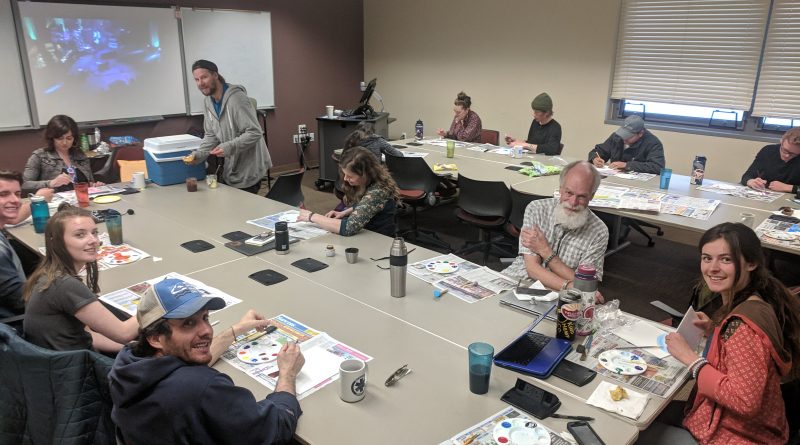
Teaching & Learning
Preface
My teaching philosophy, pedagogue, and practice are difficult to put in words. Feelings of anxiety and imposter syndrome have made this section a challenge for me. It has led me to consider how I would talk to a student who may feel the same way about one of my assignments. I would suggest the student think small, break it down, and know that there are no bad ideas in a brainstorm. Having a classroom with community members who are eager to learn is an absolute gift and my approach to serving students has evolved over the years. However, it has always remained rooted in the beliefs that student participation is necessary, trust in the classroom facilitates openness, collaboration enhances learning, and content should mirror the real world.
Philosophy of Education
To summarize a teaching philosophy of teaching it is like attempting to describe who you are as a person. There are many factors that contribute to my understanding of the role that education plays in the lives of our students.
WE ARE ALL LEARNERS AND TEACHERS- We learn together in my classes. In a psychology class, I am not the only expert in the room (or any room for that matter). Everyone arrives to class with relevant experiences, insight, and knowledge. It is my job to bring this wisdom out so we can learn together. Facilitating a collaborative team environment in the classroom is beneficial to everyone and is proven to be an effective strategy (Duran & Miquel, 2019). Learning can happen in many ways, and peer to peer is highly effective.
CONNECTION, TRUST, & POSITIVE ENVIRONMENT- The foundation of learning is connection. Connection to material, ideas, and content, but also a connection to a teacher, classmates, and the world. Building connection in the classroom is essential to building trust and creating a positive learning environment. “Student–faculty interactions can be formal or informal… with both playing an important role in determining students’ academic success” (Komarraju et al., 2010, p. 332). Establishing trusting relationships with our students is foundational to everyone’s success.
TEAMWORK MAKES THE DREAMWORK- It takes a village. We’re all in this together. Insert any saying you have about the value of collaboration, it is essential for students, professors, and CMC to succeed. We have a gift within our college. A diverse group of students with a myriad of backgrounds, wisdom, and experiences. Colleagues with highly congruent skill sets and expertise who are willing to cooperate and deepen the learning environment. It is our responsibility to unify all these people to enhance student’s experiences.
“…by welcoming all learners through its doors, delivering highly relevant education and training, and serving as a trusted partner for strategic collaboration and innovation.”
~CMC Vision
MAKE CONTENT REAL, RELEVANT AND PRACTICAL- Making psychological content relevant is critical. It requires that I find useful resources, facilitate meaningful discussions, and create applicable activities that help to personalize the concepts and allow the content to expand beyond the classroom and into students’ lives. Making content personal to a student helps them to engage. “Postsecondary institutions must enact a variety of policies, programs, and practices to engage students more fully in educationally purposeful activities in order to help them succeed and enrich their learning” (Kuh, 2016, p. 56). Class content matters and, when it can be applied directly to students’ lives, the opportunity for learning is bountiful. It is my responsibility to be a bridge from content to application.
Approach to Pedagogy
My pedagogue builds upon my philosophy of learning. It moves beyond the intent of education into the application. Establishing course materials and resources, designing discussions, and prepping the course in meaningful ways that enhance learning.
WE ARE ALL LEARNERS AND TEACHERS- The attitude I bring to the classroom sets the tone. It creates an environment where students feel empowered to share and help each other learn. I learn from my students every day and that knowledge and sharing enhances the experience for others. I have often had students step in to explain a lesson or topic to a classmate in a way that offered a perspective or interpretation that only they could have presented. Students sharing their stories, finding resources that may be new to me, and empowering other students to find their voice in the classroom allow for the class to thrive and us all to learn together.
“To fulfill its vision and purpose, CMC’s actions will be guided by commitments to Equity, Care, Innovation, and Integrity.”
~CMC Commitment
CONNECTION, TRUST, & POSITIVE ENVIRONMENT- Students first look to their instructors to grasp what the class is going to be. We set the tone, by creating healthy expectations, managing the classroom, facilitating positive communication, and creating positive experiences. We need to be leaders, trendsetters in order to demonstrate the attitudes we seek. Authenticity is essential. Being real, genuine, and authentic helps create trust and connection. Once this has been established, students can safely explore learning and self reflection. The resulting positive environment is a space where all people can thrive and grow, with growth being a byproduct of learning (Hardy, 2023).
TEAMWORK MAKES THE DREAMWORK- We have an abundance of incredible faculty, administrators, and staff. Collaboration is not only critical for students but is essential for us as professionals. Working with the myriad of great minds that I am surrounded by enhances the experience for students. Within the classroom, students crave connection. As a result of Covid and a movement to online learning, many lost connections. Group discussions, projects, and collaborative assignments are effective ways to promote teamwork in the classroom.
MAKE CONTENT REAL, RELEVANT AND PRACTICAL- Helping students make connections to content involves creating an environment where self awareness and curiosity meet theory and knowledge. Encouraging students to make content real to their life is at the core of all course design and creates a learning experience that will allow students to understand content in a way that they can practically apply.
Learning in Practice
Finally, the practice of learning and education is application. Just as pedagogue builds on philosophy, practice is a unification of the two.
WE ARE ALL LEARNERS AND TEACHERS – My belief that students’ voice in the classroom is paramount has resulted in the development of practices that give them that platform. I often use assignments called Research, Reflect, and Shares to do this. Students are asked to find a resource related to the required topics and explore the relevance to what we are learning. For example, on the topic of consciousness one student may find a resource about dream analysis, another about how meditation can improve mental health, and another about how psychedelics can be used for mental illness. This allows students to explore sub-categories that interest them and share their expertise. These and similar assignments have been highly effective in allowing me to direct classes as needed to enhance student engagement. As I always say, “If it interests you, it interests me”.
“CMC cares for the people and communities it serves, and the planet — thoughtfully, intentionally, and with future generations in mind.”
~CMC Commitments
CONNECTION, TRUST, & POSITIVE ENVIRONMENT- Classrooms are scary places for some students, often entering with some level of trauma, negative academic experiences, or fears of inadequacy or belonging in a classroom. I am responsible for finding a way to teach course content while also helping to empower, embolden and instill confidence in students. Creating an environment of safety, inclusion, and acceptance allows all students to thrive. Open and direct communication starts the minute students enroll. Regularly checking in with students as people enhances that confidence with me and safety in the classroom.
TEAMWORK MAKES THE DREAMWORK- There are three collaborations that really jump out to me in the last several years as examples of teamwork that benefited students:
~The Food and Feelings collaboration between culinary, biology/nutrition and psychology was/is remarkable. This class, offered free to students and community members (10 separate events) combines the three disciplines, AND we all cook together and share a meal.
~The Nursing Mental Health simulation was an opportunity for nursing students to practice working with mental health “patients” portrayed by my Abnormal Psychology students, using their knowledge from class.
~The ELL/PSY collaboration was a great opportunity for some of our ELL students to experience a college class. Students who were taking ELL classes had the opportunity to co-enroll in Psychology 101. In this model, I attended their class in order to review the upcoming psychology class content. The students were highly supported and empowered.
MAKE CONTENT REAL, RELEVANT AND PRACTICAL- The best place to see relevance is when students apply content to their lives. I created two assessments that allow students to apply content to their lives: a mood meter for students and behavioral assessment meter. Students use these instruments to understand how their decisions influence mood. Numerous students still use this today even after the course concluded. My content, assignments, and discussions always conclude with reflection about how the content relates to their lives and future careers.
Class content matters. There are also essential lessons to be taught related to team-work, application, critical thinking, empathy, compassion, awareness, and so much more. Having a classroom is a gift and I am grateful for this gift.
References
~Duran, D., & Miquel, E. (2019). Preparing Teachers for Collaborative Classrooms. Oxford Research Encyclopedia of Education. Retrieved 22 Oct. 2024, from https://oxfordre.com/education/view/10.1093/acrefore/9780190264093.001.0001/acrefore-9780190264093-e-780.
~Hardy, F., Chee, P., Watkins, V., & Bidgood, J. (2023). Collaboration in Social Work Field Education: A Reflective Discussion on a Multiuniversity and Industry Collaboration. Australian Social Work, 76(4), 603–611. https://doi.org/10.1080/0312407X.2021.1924811
~Komarraju, M., Musulkin, S., & Bhattacharya, G. (2010). Role of Student–Faculty Interactions in Developing College Students’ Academic Self-Concept, Motivation, and Achievement. Journal of College Student Development 51(3), 332-342. https://dx.doi.org/10.1353/csd.0.0137.
~Kuh, G. D. (2016). Making Learning Meaningful: Engaging Students in Ways That Matter to Them. New Directions for Teaching and Learning, 145, 49–56.
